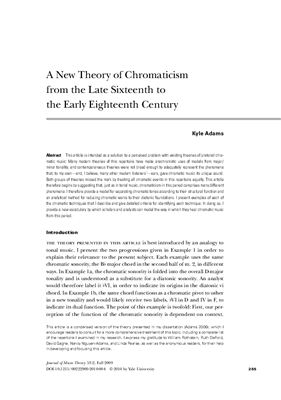Joual of Music Theory Fall 2009 53(2): 255-304
Abstract This article is intended as a solution to a perceived problem with existing theories of pretonal chromatic music: Many mode theories of this repertoire have made anachronistic uses of models from major/
minor tonality, and contemporaneous theories were not broad enough to adequately represent the phenomena that, to my own—and, I believe, many other mode listeners’—ears, gave chromatic music its unique sound.
Both groups of theories missed the mark by treating all chromatic events in this repertoire equally. This article therefore begins by suggesting that, just as in tonal music, chromaticism in this period comprises many different phenomena. I therefore provide a model for separating chromatic tones according to their structural function and
an analytical method for reducing chromatic works to their diatonic foundations. I present examples of each of the chromatic techniques that I describe and give detailed criteria for identifying each technique. In doing so, I provide a new vocabulary by which scholars and analysts can model the way in which they hear chromatic music from this period.
Introduction
the theory presented in this article is best introduced by an analogy to
tonal music. I present the two progressions given in Example 1 in order to
explain their relevance to the present subject. Each example uses the same
chromatic sonority, the B? major chord in the second half of m. 2, in different
ways. In Example 1a, the chromatic sonority is folded into the overall D-major
tonality and is understood as a substitute for a diatonic sonority. An analyst
would therefore label it ?VI, in order to indicate its origins in the diatonic vi
chord. In Example 1b, the same chord functions as a chromatic pivot to usher
in a new tonality and would likely receive two labels, ?VI in D and IV in F, to
indicate its dual function. The point of this example is twofold: First, our perception of the function of the chromatic sonority is dependent on context.
Abstract This article is intended as a solution to a perceived problem with existing theories of pretonal chromatic music: Many mode theories of this repertoire have made anachronistic uses of models from major/
minor tonality, and contemporaneous theories were not broad enough to adequately represent the phenomena that, to my own—and, I believe, many other mode listeners’—ears, gave chromatic music its unique sound.
Both groups of theories missed the mark by treating all chromatic events in this repertoire equally. This article therefore begins by suggesting that, just as in tonal music, chromaticism in this period comprises many different phenomena. I therefore provide a model for separating chromatic tones according to their structural function and
an analytical method for reducing chromatic works to their diatonic foundations. I present examples of each of the chromatic techniques that I describe and give detailed criteria for identifying each technique. In doing so, I provide a new vocabulary by which scholars and analysts can model the way in which they hear chromatic music from this period.
Introduction
the theory presented in this article is best introduced by an analogy to
tonal music. I present the two progressions given in Example 1 in order to
explain their relevance to the present subject. Each example uses the same
chromatic sonority, the B? major chord in the second half of m. 2, in different
ways. In Example 1a, the chromatic sonority is folded into the overall D-major
tonality and is understood as a substitute for a diatonic sonority. An analyst
would therefore label it ?VI, in order to indicate its origins in the diatonic vi
chord. In Example 1b, the same chord functions as a chromatic pivot to usher
in a new tonality and would likely receive two labels, ?VI in D and IV in F, to
indicate its dual function. The point of this example is twofold: First, our perception of the function of the chromatic sonority is dependent on context.

